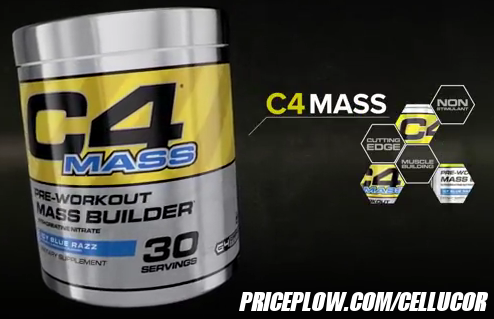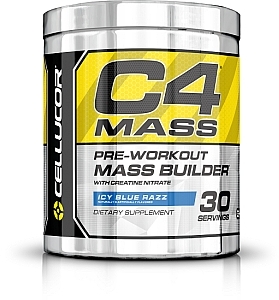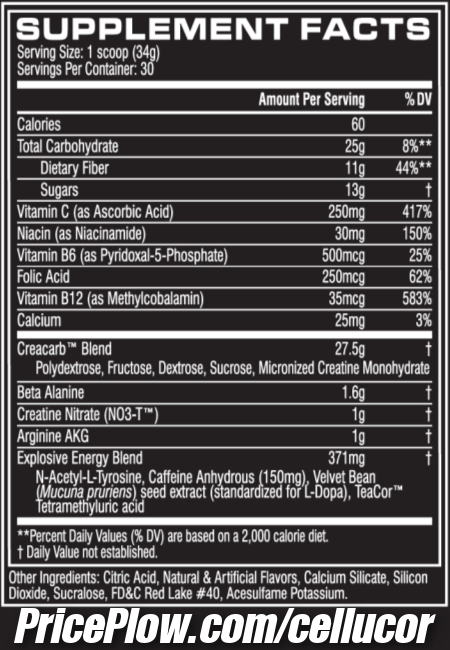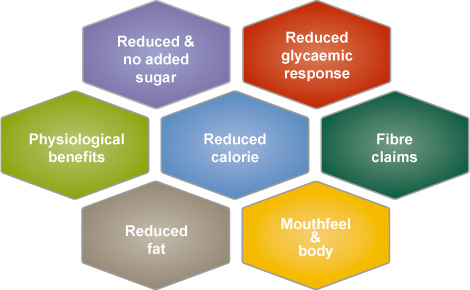The new Cellucor C4 Mass supplement is now out, and it's different from any bulking supplement you've ever seen. Cellucor has not only added new stimulants (same as with the new C4 formula), they've carbo-loaded this one as well - a great idea for the C4 users who are in serious bulking mode.
But the type of carbs is where Cellucor threw the curveball!
Before we get started, you can compare prices using PricePlow below, and sign up for price drop updates so that you stay on top of the best deals as more stores get it in stock:
Cellucor C4 Mass – Deals and Price Drop Alerts
Get Price Alerts
No spam, no scams.
Disclosure: PricePlow relies on pricing from stores with which we have a business relationship. We work hard to keep pricing current, but you may find a better offer.
Posts are sponsored in part by the retailers and/or brands listed on this page.
The C4 Mass Ingredients
To the right, you can see the ingredient label. We discuss the changes and get into some specifics below.
-
More caffeine than C4 Extreme
The "Explosive Energy Blend" is packed with a 371mg total proprietary blend of caffeine anhydrous, n-acetyl-l-tyrosine, velvet bean seed extract and TeaCor (Theacrine - tetramethyluric acid). We know that 150mg of that is caffeine anhydrous, or the equivalent of about a cup and a half of coffee.
Just like with the new C4 formula, this has 15mg more caffeine, and also has the added Theacrine. However, there's no longer synephrine, the popular beta-2 adrenergic fat burner, which functioned as a mild adrenaline booster in the original C4 Extreme.
Whether or not these stimulants will hit you harder than the original C4 Extreme depends on your caffeine tolerance, and how well you enjoy the Theacrine vs. synephrine.
-
Carbs!!
Here's where C4 Mass changes it up. The previous Cellucor pre workouts that contained carbs were under the M5 product line - but M5 Reloaded was stimulant-free, so this is already different.
The centerpieces of M5 were the "Creatine Matrix" and the "Carb Pump Matrix." These are mushed together into the "Creacarb Blend" in C4... but we're not entirely enthused about this new direction.
This new formula hides the creatine content in a total 27.5g blend that also contains the basic sugars that make up the bulk of the carb content, but below we do the math to figure it out.
The biggest question we have is about all the fiber content -- and then we discuss how much creatine is inside.
Why all the fiber (11g, from Polydextrose) in a pre workout?
The Creacarb Blend relies on simple fructose, dextrose and sucrose for a quick carb load. But it's actually primarily composed of polydextrose, a synthetic soluble fiber[1] that's sometimes seen in protein powders.
The total fiber number is 11g, quite a bit for a pre workout, but realize that this is "fake fiber", if you will, so it's not the same as something like psyllium.
Our experience so far has been very positive with polydextrose, and we're all for it at the right time. After all, it doubles as a sweetener, which is great for those certain protein powders.
But take a look at the main "benefits" of polydextrose:
-
Satiety / Appetite Suppression
The benefits of Polydextrose, as shown by one of the raw materials suppliers. They're great and we've loved this stuff in protein powders, but how about in pre workouts?
A study performed on DuPont's Litesse (which is their polydextrose product) showed that adding this to your mid-day meal will help you feel fuller.
Oftentimes, when appetite is suppressed, users just make up for it later on. That was not the case with this study -- they never compensated for that decreased mid-day caloric intake![2]
That's great if we're dieting... but isn't C4 Mass supposed to be for bulkers? Don't we want to be hungry, to a degree?
So, note that if you take this, you should still count your macronutrients and get your carbs in.
The good news is that if you've ever seriously tracked your calories with a calorie counting app or website, you'll probably note that your fiber is often too low. If that's the case, this is going to help fill a gap that even bulkers want filled.
-
What about loose stool? This is fiber, after all...
The good news with polydextrose, compared to other fiber-based ingredients, is that it takes far higher doses to cause severely loose stools (ie diarrhea). One study estimated it at ~90g or greater in order to get loose stools.[1]
That's good news, because you'd need 8 scoops of C4 Mass to hit that number - something you obviously shouldn't be doing.
The flip side of this is that other research has stated that it does have laxative effects:
Inulin and polydextrose show many of the same functionalities of grain fiber in the large intestine, in that they are fermentable, bifidogenic, and laxative.[3]
Another study (which studied "five-day fecal wet weight") is a bit more alarming - in healthy men, 20g daily of polydextrose resulted in softer stool - moreso than soluble corn fiber or a low-fiber control![4]
And if you take two scoops of C4 Mass, you're going to be over that 20g number. This isn't necessarily a horrible thing -- softer stool does not equal diarrhea -- but it's worth understanding if you're sensitive to fiber, already have soft stools, or already have a high-fiber diet.
So with all this said, we're still cautious about blindly recommending this to anyone. C4 Mass delivers a whopping 44% of your daily dietary fiber per serving -- so if you're already high in fiber, you might want to adjust your diet.
Again, this might be a good thing, because most of us don't get enough fiber. But it's going to come down to personal preference.
Maybe Cellucor knows something we don't. Maybe this much polydextrose provides for some crazy pumps that you need to experience.
Note the calories
Pure conjecture here, but perhaps the polydextrose was added to make the calorie number look small (60 calories) while the carb numbers look "big" (25g carbs, 11g fiber, 13g sugar). That's an interesting profile, and is what happens when this ingredient is in the mix.
Overall, we like things that are different -- there's so many pre workouts that it's good to have a new variety -- but you should try this with one scoop for starters, and look at your diet and determine where your pre-existing fiber intake is. Chances are, it's low, and this is one way to get it to normal levels.
-
-
How much creatine?
We HATE it when pre workouts underdose their creatine. In C4 Mass's case, this is not a problem despite having to bust out a calculator - creatine done right!
So are we actually getting as much creatine content than there was in M5? The answer is no, but it's still a perfectly fine dose.
The previous formula was proprietary, but you at least knew you were getting 4.5g of creatine in one form or another.
To figure C4 Mass out, we need to do a bit of math. We now know there's one gram of creatine nitrate, since that's separate on the label. That starts us with 675mg of actual creatine (the creatine-nitrate bond is 67.5% creatine, 32.5% nitrate).
The remaining creatine content is micronized creatine monohydrate in the Creacarb blend. A touch of math tells you that there's 2.5g creatine monohydrate, since the Creacarb blend is 27.5g and there are 25g of carbs in the total product, with Creacarb providing the only carbs available.
This puts us at a total of 3.175g creatine, which makes for an efficacious dose - 3-5g per day is the keystone. This is especially fine since some users will opt for 1.5 scoops of C4 Mass.
It's a bit annoying that we have to do math to see how much creatine is here, but the math at least checks out.
Note that compared to M5, the magnesium chelate and Creasorb blend seem to entirely be gone from C4 Mass - not a huge loss there - we'll take C4 Mass's.
What else is in there?
-
Beta Alanine
Beta alanine is the amino acid you want for muscular endurance.[5] It boosts your overall levels of carnosine in muscle tissue, which in turn cuts down on the acids that make muscles feel fatigued.
The 1.6g per serving can be considered a half-dose based on what research has found to be effective so far, but it's also a "safe" amount chosen by many products to reduce the intense tingling sensation that some people get with a full dose (especially when in a stim-heavy blend).
If you know about beta alanine, then skip down to the Theacrine section below! It's similar to caffeine, but definitely not the same
-
Arginine AKG
AAKG provides a very small nitric oxide boost, but it's not always as reliable in that capacity (for example, some studies have shown it to be effective, others in athletes have not.[12]) Anecdotally, we like it more than the average user, but it seems to vary from person to person.
But that's not where it's most useful here anyway:
Instead, it's more useful in preventing the body from building a nitrate tolerance.[6] That's fine, since there is creatine nitrate, and the nitrate is what should provide more pumps anyway.
-
N-Acetyl-L-Tyrosine
Along with the caffeine, this focus-booster seems to make up the bulk of the energy blend. L-Tyrosine in general is well-supported by science as a very effective attention enhancer and fatigue reducer, and the N-Acetyl variant is the most bioavailable version, so this is definitely a good thing.[7,8] The only question is whether this dosage is enough, as effective dosages in studies have been as high as three times what's included here.
-
Velvet Bean Seed Extract
The important part of the velvet bean extract is the L-Dopa, the presence of which stimulates dopamine in the body.[9] The dosage here is likely too low to effectively stimulate growth hormone, so it's probably just included as a mood enhancer.
We believe that this has always been one thing that's made everyone love C4 in the past, yet other companies ignore too frequently, giving the C4 family some distinguishment from the rest.
-
TeaCor Theacrine
Here's where we (and Cellucor) are hoping for a longer-lasting energy that doesn't fade as you get through your tub.
TeaCor is a proprietary theacrine formulation. Theacrine is an up-and-coming stim that has the effects of caffeine but doesn't build tolerance nearly as quickly, which addresses the main issue most users had with the previous C4 Extreme formula.
It also synergizes with caffeine's energy effect and the stimulation of dopamine.[10,11] It's new and relatively untested, but it shows a lot of promise and we're excited to see how it performs out in the wild.
Final Word
Basically, this is a version of the new C4 that was released a few months ago with some new carb content and an approved dose of creatine thrown in. The focus is on mass more than pumps, but at only 60 calories per serving it's actually a little bit leaner than M5.
That's a little odd for what appears to be a bulking supplement, but given how "sloppy" our diets can get when trying to put mass on... it's not necessarily a bad thing to have that fiber in there.

We've been hearing about it for months, and it's finally here in 2015. Are you going to try it?
The mix of simple carbs plus the newly-enhanced Energy Blend should at least be legit as a quick energy enhancer, however. You'll be able to pick it up in Icy Blue Razz and Fruit Punch flavors, and can compare prices and sign up for price drop updates using PricePlow below:
Cellucor C4 Mass – Deals and Price Drop Alerts
Get Price Alerts
No spam, no scams.
Disclosure: PricePlow relies on pricing from stores with which we have a business relationship. We work hard to keep pricing current, but you may find a better offer.
Posts are sponsored in part by the retailers and/or brands listed on this page.








Comments and Discussion (Powered by the PricePlow Forum)